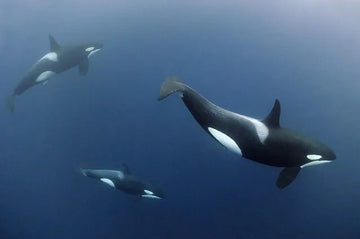The killer whale (Orcinus orca) is an odontocete cetacean in the family Delphinidae, one of the most popular cetaceans because of its nickname, the killer whale, and because it is used as a show in aquatic parks.
The killer whale has a striking colour pattern consisting of well-defined areas of glossy black and cream or white. The upper part of the body is black, with a pale white or grey "saddle" pattern behind the dorsal fin. It has a white "patch" behind and above each eye. The chin, throat, belly and underside of the flippers are white. Each individual killer whale can be identified by its markings, the shape of its "saddle" patch, and the shape and color of its dorsal fin.
Another distinctive feature of the killer whale is its dorsal fin, which can reach almost 2 meters in length in males and is shaped like an isosceles triangle. The dorsal fin is often notched, cut, scarred and indented. The paddle-shaped pectoral fins are broad, rounded and can reach 1.8 meters in length and almost 1 meter in width. Males can grow to 9.5 meters long and weigh 9 tonnes. Females are slightly smaller at 8.2 meters and lighter at 4 tonnes.
Shirts for Orca Lovers - Worldwide Shipping!
SEE MORE SHIRTS FOR OCEAN LOVERS
The killer whale's mouth is large and well adapted for hunting. It has 46 to 50 conical teeth that point slightly backward and inward. The upper and lower teeth allow them to block their prey and break it into smaller pieces for easier swallowing. Depending on the population and geographic area, the diet of killer whales varies. They generally feed on sea lions, elephant seals, seals, porpoises, squid, sharks, penguins, small whales such as beluga whales and narwhals, and large baleen whales such as gray whales, both adults and especially their calves.

Killer whales work in groups to hunt gray whales
The name "killer whale" (although it is no more "killer" than any other predator) is due to the fact that it is a fast and skilled hunter with a complex social structure, capable of hunting in teams like other dolphinids such as the bottlenose dolphin.
Although there are no documented cases of killer whales attacking humans in the wild, there have been attacks on caretakers in marine parks, resulting in more than one death.
BBC report on orcas
They have been studied extensively both in the wild and in captivity, but little is known about the breeding habits of killer whales. There are females that give birth throughout the year, suggesting that mating may occur at any time without a specific breeding season. In the wild, killer whales reach sexual maturity between 10 and 18 years of age and are considered to be of breeding age when the male reaches 5 meters and the female 4 meters in length. Females in captivity may give birth to a calf every two years, but the usual period in the wild is 3 to 5 years. The gestation period is estimated to be between 13 and 17 months, and at birth the calves measure between 1.8 and 2 meters and weigh 180 kilograms.
Killer whales inhabit all the world's oceans, although they are more abundant in colder waters. Unlike other cetaceans, which follow a regular migration route each year, the killer whale seems to travel according to the availability of food, in fact they are one of the few cetaceans that move freely from hemisphere to hemisphere.

Killer whales generally live in groups consisting of several females, calves, juveniles and one or two males. Some groups are composed of a mother and her calves that remain with her for life. This type of matrilineal family structure has been observed in the U.S. Pacific Northwest where resident groups are stable and have formed a family with several matriarchal generations traveling together. Different studies have proven that each of these groups has its own "dialect". Mothers are very protective of their calves, with documented cases of killer whales protecting and caring for sick and injured mates.
Although killer whales are widely distributed, their global population is still unknown. Because of their size, aggressiveness, and the fact that they travel in groups, they have no natural predators and are not hunted as much as whales, but they do face several threats. Both synthetic chemical spills and declining fish stocks around the world have a direct impact on killer whale populations by reducing the numbers of seals and sea lions, which are often the killer whales' primary prey.























